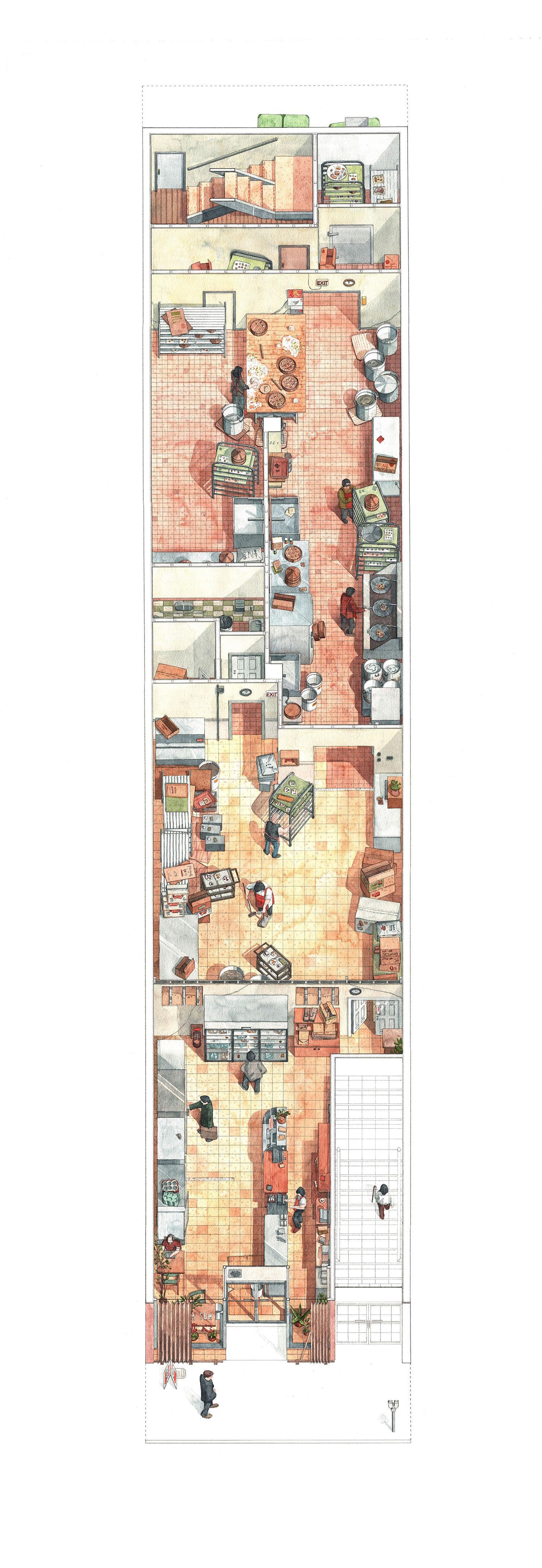Watching Paint Dry
Contributor
Rendering Fiction

Against the effortless click of a screenshot and the pulsing clarity of real-time rendering, drawing by hand and watching paint dry appears indulgent and demands frequent justification. Under the current mantra of quick production and even quicker consumption, defenders of hand drawing have largely resorted to the aphorism that sketching is the most direct, if not the quickest, translation of observations or thoughts onto paper. While these claims may be true, if we are to abandon the pursuit of speed—operating deliberately slow, indirect, and imprecise—we may find that the act of representation itself can yield more creative methodologies. To illustrate this, allow me to elaborate on my use of large-scale paintings as a form of architectural research in my studies of dim sum restaurants across the Pacific.
Long before putting pen to paper, my search for a subject matter begins on Google Maps. Patrons’ photos and reviews help compile a shortlist of dim sum restaurants to visit. Fueled by the thrill of unfamiliarity, observations from the first visit prove uniquely acute and prime for documentation. New iPhones are equipped with LiDAR scanners capable of 3D scanning interior spaces, a technology that requires the phone’s owner to point obnoxiously over every nook and cranny. I prefer to keep my surveys covert and unobtrusive. Before entering the dining hall, I clutch my phone to my shoulder and start recording stealthily. It only takes several laps around the dining room to produce a video walk-through that locates key circulatory routes and general interior layout. Once I sit down at a table, I count the floor tiles and sketch an annotated plan—all while savoring morsels of dim sum.
These on-site recordings sit idly in my phone and notebook while I begin months of archival research on each restaurant. As memories of my visit fade, the readings buttress first hand experiences. By the time I build a digital three-dimensional model, historical time and knowledge has complicated an otherwise simple process. Referencing blurry memories, choppy video footage, rough sketches, historic photos and writings, the modeling process becomes a tug-of-war between divergent perspectives and hazy recollections. The resulting model reflects this: a three-dimensional Hockney collage. Multiple memories, histories, and viewpoints create a disjointed and incomplete space that embodies a sense of plurality. I am now tasked with, not a forceful homogeneity, but a delicate seaming. In my large-format paintings, this pursuit involves two techniques: axonometry, and the cut line.
From cubes drawn by children to furniture diagrams in IKEA manuals, axonometry’s apparent legibility and technicality belie its capacity for illusion. Parallel projection collapses visual depth, allowing far apart objects to line up and appear as though they are connected. While Piranesi’s Imaginary prisons hide impossible stairs to produce a coherent perspectival image, axonometry allows the video game Monument Valley to flaunt impossible staircases front and center without arousing immediate suspicion. Axonometry sets up a convincing framework for bringing together a fractured space.
The cut line takes many forms. It can be a border delimiting the painting’s edge, a plane clipping through a three-dimensional model, a silhouette staging the composition… In each case, the cut line selectively removes information to make sense of the image. The cut line is not poché, which emphasizes the thing-ness of what is blacked out. The cut line produces voids by leaving the paper exposed, resulting in a blankness that operates similarly to Damisch’s /cloud/—as an alternative to linear perspective 1 . Yet rather than the ephemeral and blurred edges of the /cloud/, the cut line—a line after all—delineates. Adhering to axonometry, the cut line’s rigidity reinforces the projection’s connective capacity.
Employing this representational trickery, the disjointed three-dimensional model produces a cogent two-dimensional linework. The digital drawing is then transferred onto watercolor paper. It is the one step I have chosen to expedite. The Zund machine’s robotic arm, drawing at a stunning rate of up to six meters per second, imposes a distance between myself and the image that later allows me to return to this work anew.
With fresh eyes, I begin painting. Watercolor’s sensitivity to moisture transforms the process into a dance where I follow the materials’ tempo. In rhythm with the moisture of the brush, the thickness of the paper and the humidity of the air, I reference the original video footage to reinvigorate each brush stroke. The linework takes away the stress of painting accurately and the time spent watching paint dry becomes a special time for reflection.
From the choice of subject matter to the final stroke, each painting’s creation is deliberately circuitous. The slow and phased process accumulates information over time and produces a palimpsest of spatial knowledge. Each step locks in a different aspect of the space and subsequent layers negotiate with what is already on the page to produce a cogent, but not always congruent, rendition of a place. The resulting painting showcases a spatial imaginary that is more than a cognitive reproduction of a space itself. Each painting, imbued with intellectual and emotional musings, represents my intentional slow quest to understand a space.
T.K. Justin Ng is an M.Arch I Candidate (‘23) at the Harvard University Graduate School of Design.
- Hubert Damisch, A Theory of /Cloud/: Toward a History of Painting. (Redwood City: Stanford University Press, 2002). ↩︎